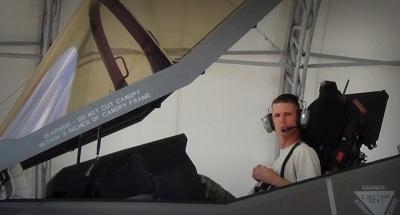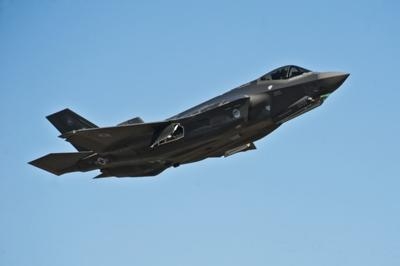First Maintenance Personnel Checked Out On Follow-On Task Procedures
An Airman seated in an aircraft, surrounded by electronic displays, surveys the cockpit of an F-35A Lightning II and begins rehearsed procedures that now feel comfortable. He feels the jet's familiar rumble below as the engine roars to life on the flightline.

If you imagined the person in the seat as a pilot, in this instance, you would be wrong.
Last week, the first few maintenance personnel in the joint strike fighter program were certified on procedures for F-35A engine runs - two Air Force crew chiefs and two civilians from Air Force Engineer Technical Services. The accomplishment is yet another milestone toward organic maintenance capability, which reduces the need to rely on outside agencies. "It feels pretty good starting the whole development of this program and being the first enlisted person to run an [F-135] engine," said Tech. Sgt. Jeremy Pressley of the 58th Aircraft Maintenance Unit.
Pressley completed his first engine run Sept. 10 and will be an instructor for the select few maintainers chosen to go through the engine run course. The structure of the class is currently in the validation process. It was developed primarily by AFETS technicians Lou Sirois and Mike D'Ingillo, who combined have more than 40 years prior experience in the Air Force and an additional 17 years with AFETS. In June, they began working with instructor pilots on the program, and now serve as third-party certifiers for the Air Force on this critical course.
Once an experienced maintainer spends two days in the classroom with Pressley, he/she must pass tests on general and emergency procedures before moving on to a simulator. The training in the simulator allows maintainers to get comfortable with practicing for emergencies, such as an engine fire or uncommanded auto-acceleration that leads to "jumping chocks."
Sirois or D'Ingillo will spend the last day of the course certifying maintainers to do engine runs on an actual jet. "It's a dynamic situation when you're in there," D'Ingillo said. "You need to be quick on your feet."
Engine runs are a fairly common follow-on maintenance task, required after engine installations and for leak checks and operational checks of specific components, for example. As the 58th Aircraft Maintenance Unit builds up to full capability, engine runs will be part of daily operations. "In a typical AMU, you're doing multiple engine runs in a day," said Chief Master Sgt. Christopher Bennett, who leads the airframe powerplant general section. "It's a great deal of responsibility."

Previously, the unit could only use trained pilots to conduct engine runs. Lt. Col. Lee Kloos, 58th Fighter Squadron commander, said initially running engines provided valuable training for pilots, but balancing the benefit of that exposure with managing pilot work load has become a challenge. "We have a limited number of pilots available to support flight operations and maintenance. We continue to qualify our initial cadre pilots to fly the F-35A while the Operational Utility Evaluation (OUE) is underway as we anticipate a transition to formal syllabus training." he said. "The OUE will include a complete checkout of the ground and flight operations segments of the syllabus, as well as a checkout of the logistics and maintenance procedures to ensure we are able to sustain a sufficient sortie generation rate."
Tech.Sgt. Rawleigh Smith said the fifth generation aircraft technology requires the keen ability to monitor the Panoramic Cockpit Display while referencing a laptop with the necessary technical data. The engine lead for the 58th AMU is familiar with KC-135 maintenance, which he could check four engines at a time versus only running one F-35A engine.
"It is a daunting task for maintainers who have never run an engine before; however, the crew chiefs who will be selected for certification have previous experience on other airframes," said Smith. "The more you do it, the more comfortable you get. It was fun."
The next group of seven-level crew chiefs are scheduled to go through an official engine run course as early as the end of 2012.
(Pictured: Tech. Sgt. Jeremy Pressley, of the 33rd Maintenance Operations Squadron, is the first maintainer to complete an F-135 engine run.)
 ANN's Daily Aero-Linx (04.13.24)
ANN's Daily Aero-Linx (04.13.24) ANN's Daily Aero-Term (04.13.24): Beyond Visual Line Of Sight (BVLOS)
ANN's Daily Aero-Term (04.13.24): Beyond Visual Line Of Sight (BVLOS) Airborne 04.09.24: SnF24!, Piper-DeltaHawk!, Fisher Update, Junkers
Airborne 04.09.24: SnF24!, Piper-DeltaHawk!, Fisher Update, Junkers Aero-News: Quote of the Day (04.14.24)
Aero-News: Quote of the Day (04.14.24) ANN's Daily Aero-Term (04.14.24): Maximum Authorized Altitude
ANN's Daily Aero-Term (04.14.24): Maximum Authorized Altitude




